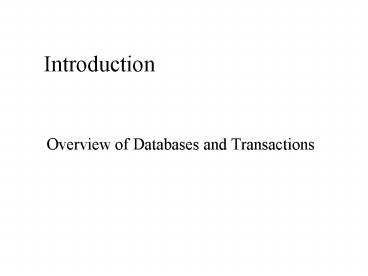Overview of Databases and Transactions - PowerPoint PPT Presentation
1 / 13
Title:
Overview of Databases and Transactions
Description:
Introduction Overview of Databases and Transactions What is a Database? Collection of data central to some enterprise Essential to operation of enterprise Contains ... – PowerPoint PPT presentation
Number of Views:240
Avg rating:3.0/5.0
Title: Overview of Databases and Transactions
1
Introduction
- Overview of Databases and Transactions
2
What is a Database?
- Collection of data central to some enterprise
- Essential to operation of enterprise
- Contains the only record of enterprise activity
- An asset in its own right
- Historical data can guide enterprise strategy
- Of interest to other enterprises
- State of database mirrors state of enterprise
- Database is persistent
3
What is a Database Management System?
- A Database Management System (DBMS) is a program
that manages a database - Supports a high-level access language (e.g. SQL).
- Application describes database accesses using
that language. - DBMS interprets statements of language to perform
requested database access.
4
What is a Transaction?
- When an event in the real world changes the state
of the enterprise, a transaction is executed to
cause the corresponding change in the database
state - With an on-line database, the event causes the
transaction to be executed in real time - A transaction is an application program with
special properties - discussed later - to
guarantee it maintains database correctness
5
What is a Transaction Processing System?
- Transaction execution is controlled by a TP
monitor - Creates the abstraction of a transaction,
analogous to the way an operating system creates
the abstraction of a process - TP monitor and DBMS together guarantee the
special properties of transactions - A Transaction Processing System consists of TP
monitor, databases, and transactions
6
Transaction Processing System
DBMS
database
transactions
DBMS
database
TP Monitor
7
System Requirements
- High Availability on-line gt must be operational
while enterprise is functioning - High Reliability correctly tracks state, does
not lose data, controlled concurrency - High Throughput many users gt many
transactions/sec - Low Response Time on-line gt users are waiting
8
System Requirements (cont)
- Long Lifetime complex systems are not easily
replaced - Must be designed so they can be easily extended
as the needs of the enterprise change - Security sensitive information must be carefully
protected since system is accessible to many
users - Authentication, authorization, encryption
9
Roles in Design, Implementation, and Maintenance
of a TPS
- System Analyst - specifies system using input
from customer provides complete description of
functionality from customers and users point of
view - Database Designer - specifies structure of data
that will be stored in database - Application Programmer - implements application
programs (transactions) that access data and
support enterprise rules
10
Roles in Design, Implementation and Maintenance
of a TPS (cont)
- Database Administrator - maintains database once
system is operational space allocation,
performance optimization, database security - System Administrator - maintains transaction
processing system monitors interconnection of HW
and SW modules, deals with failures and congestion
11
OLTP vs. OLAP
- On-line Transaction Processing (OLTP)
- Day-to-day handling of transactions that result
from enterprise operation - Maintains correspondence between database state
and enterprise state - On-line Analytic Processing (OLAP)
- Analysis of information in a database for the
purpose of making management decisions
12
OLAP
- Analyzes historical data (terabytes) using
complex queries - Due to volume of data and complexity of queries,
OLAP often uses a data warehouse - Data Warehouse - (offline) repository of
historical data generated from OLTP or other
sources - Data Mining - use of warehouse data to discover
relationships that might influence enterprise
strategy
13
Examples - Supermarket
- OLTP
- Event is 3 cans of soup and 1 box of crackers
bought update database to reflect that event - OLAP
- Last winter in all stores in northeast, how many
customers bought soup and crackers together? - Data Mining
- Are there any interesting combinations of foods
that customers frequently bought together?































